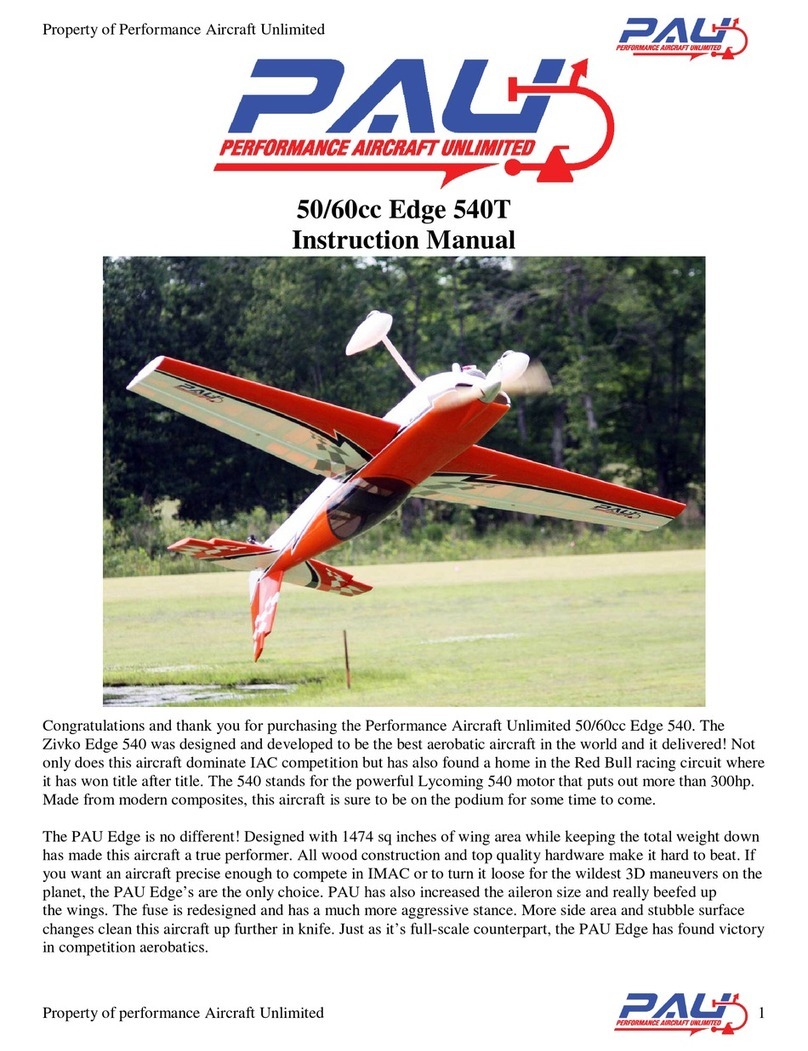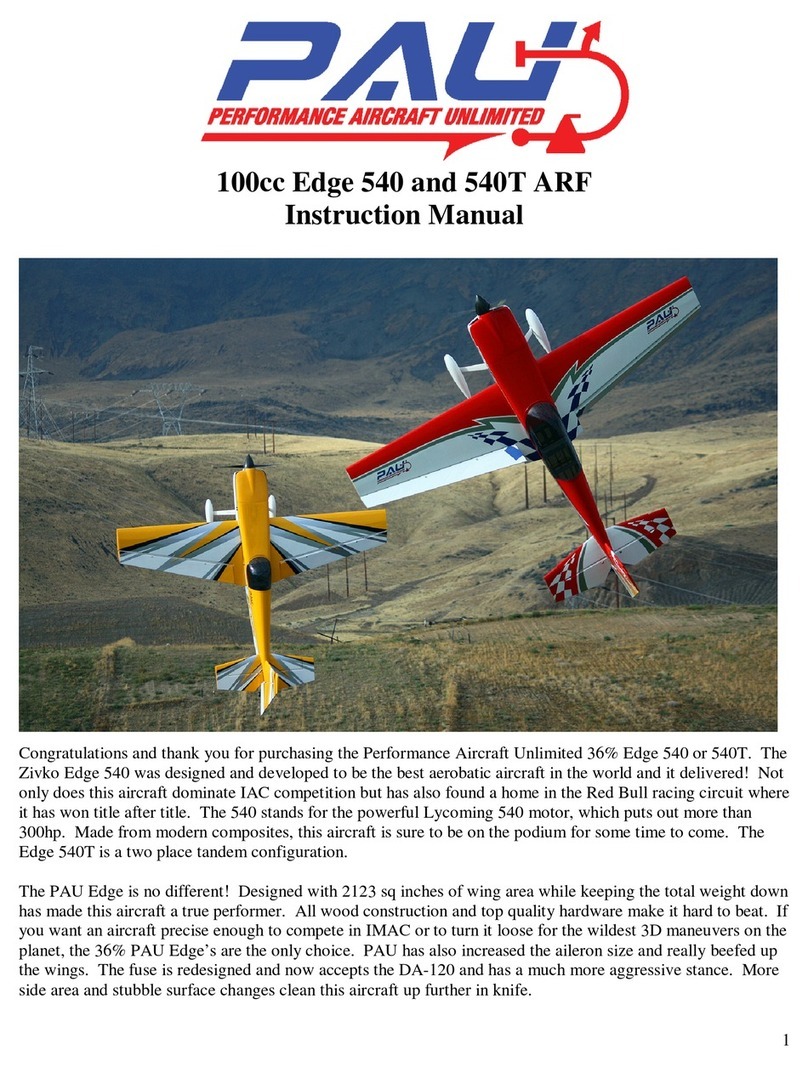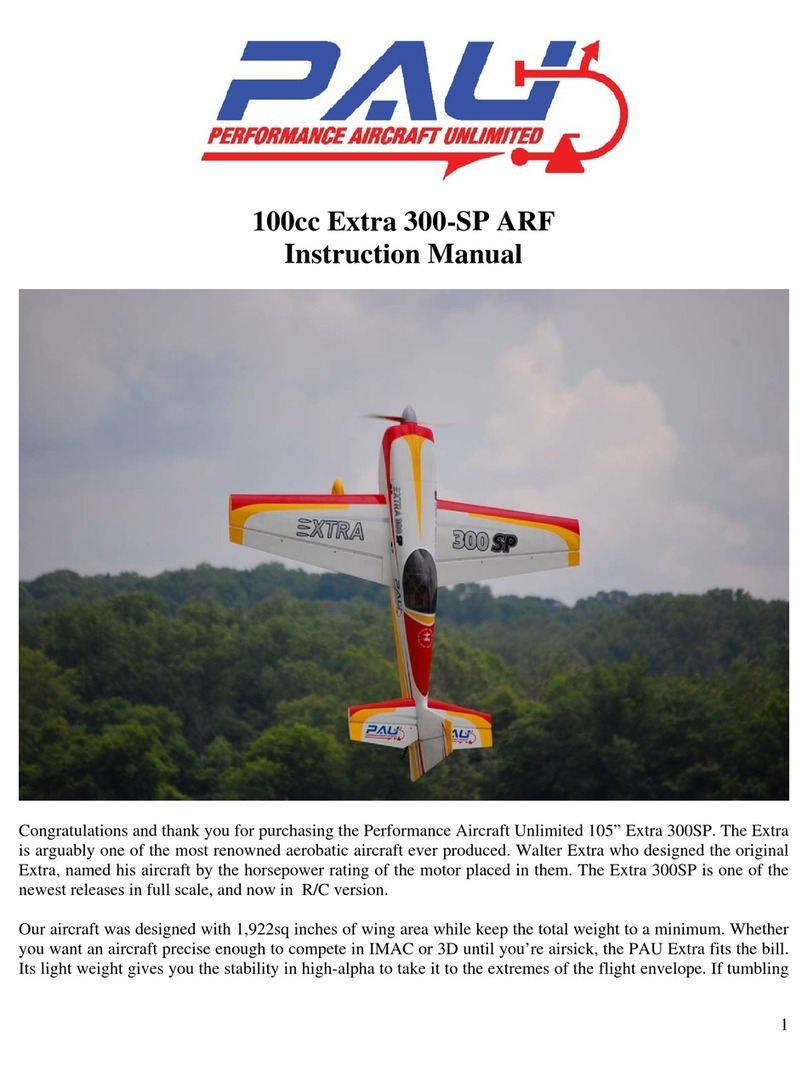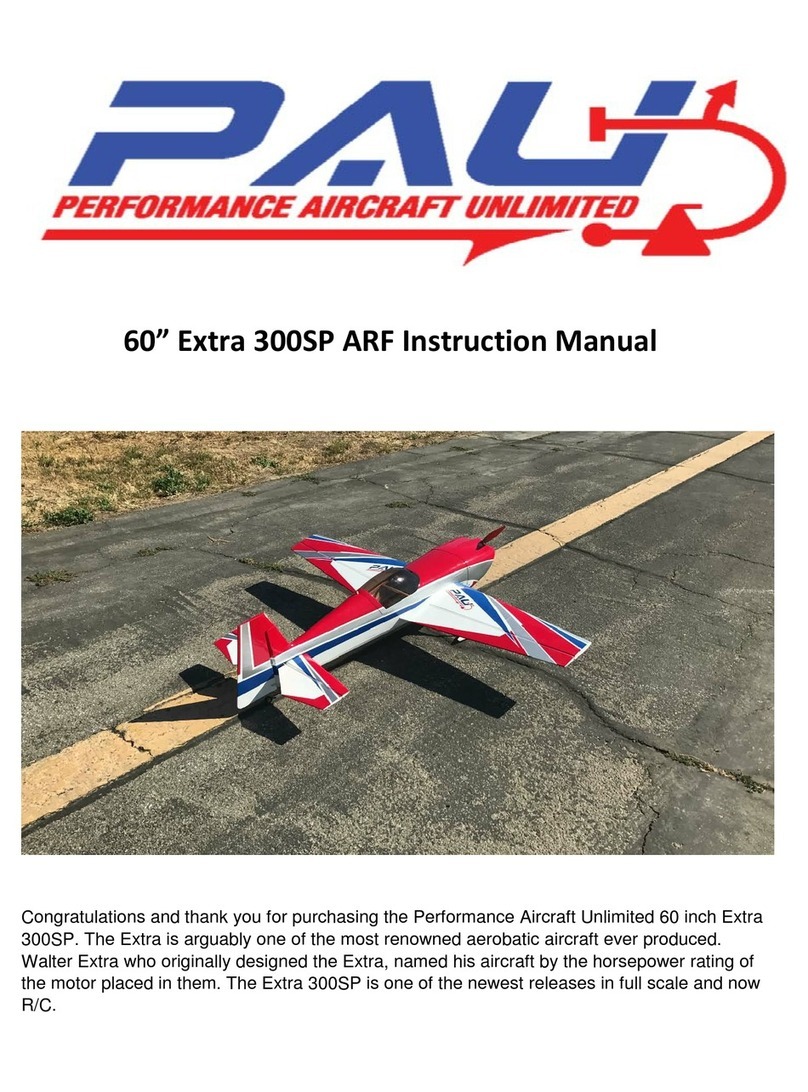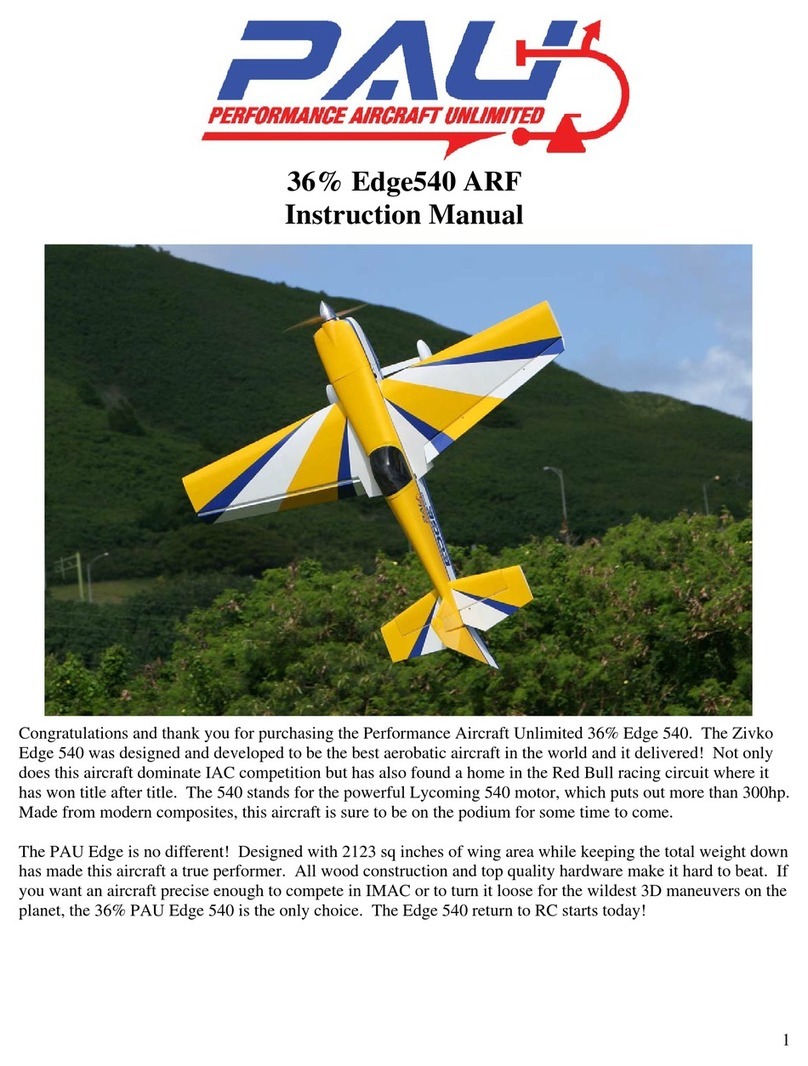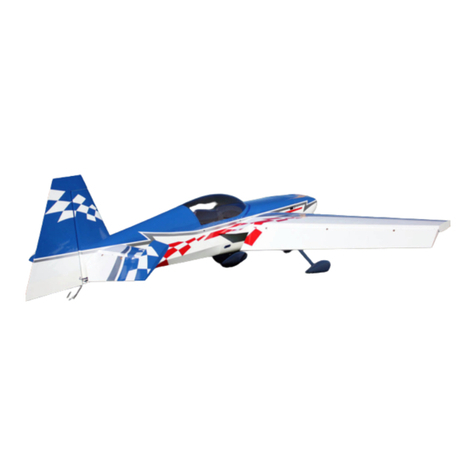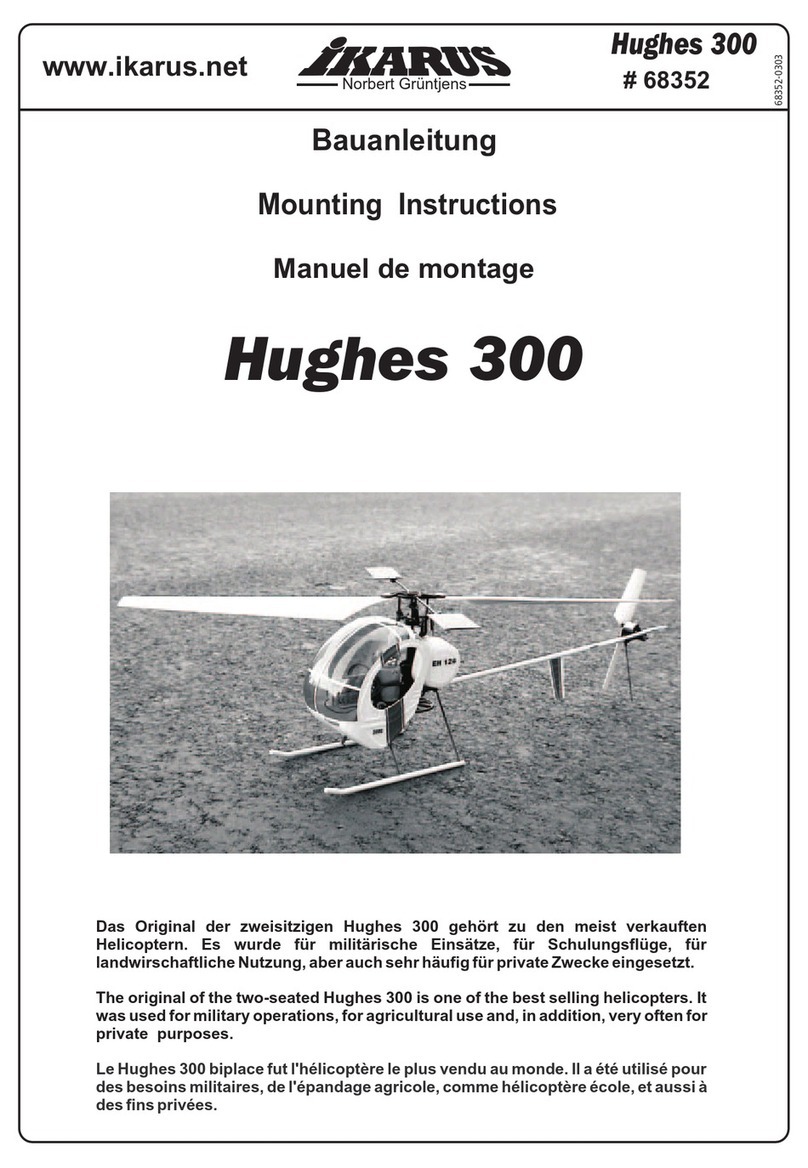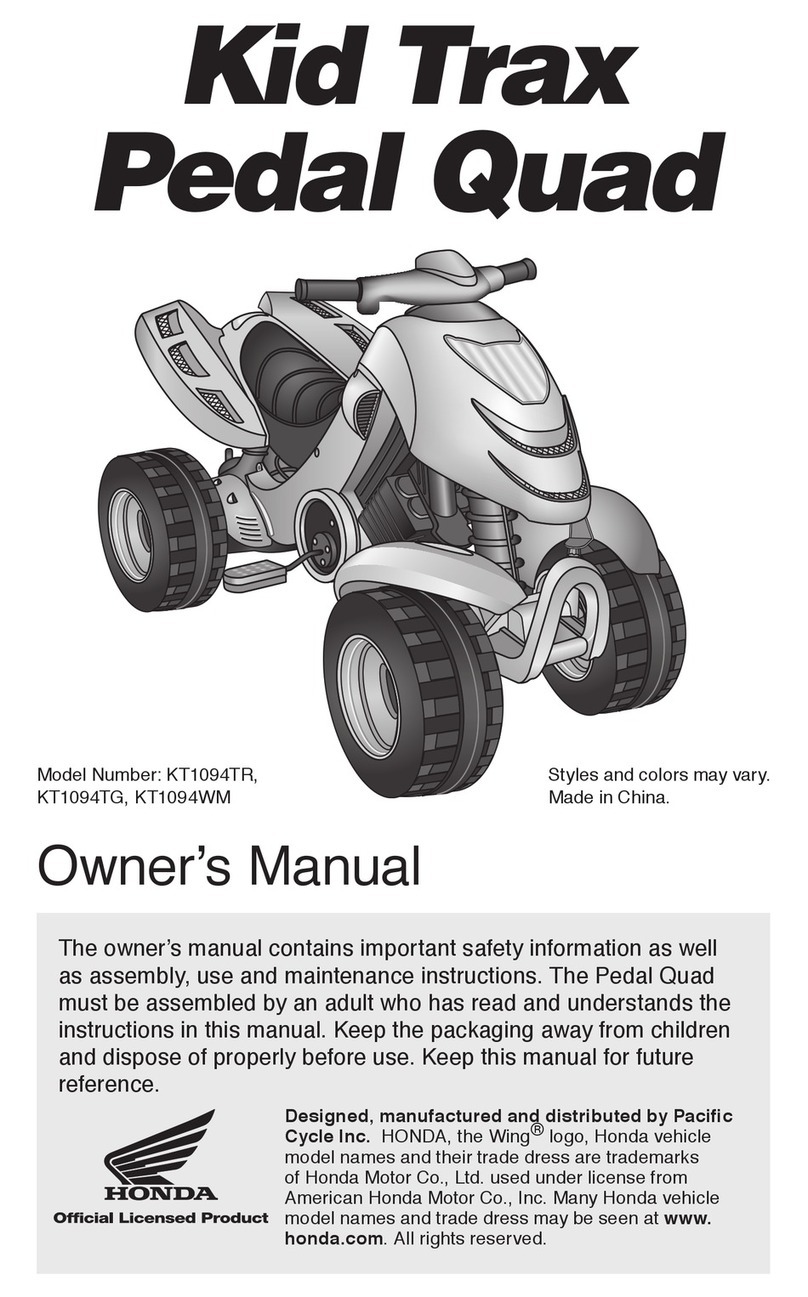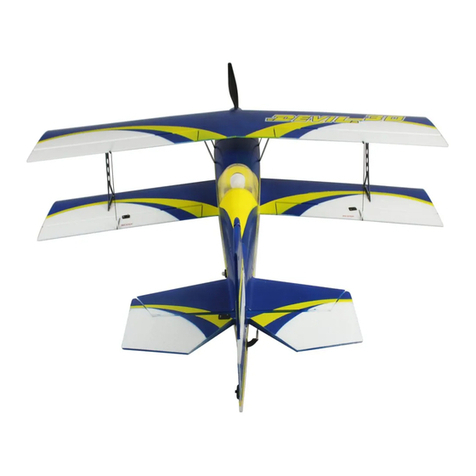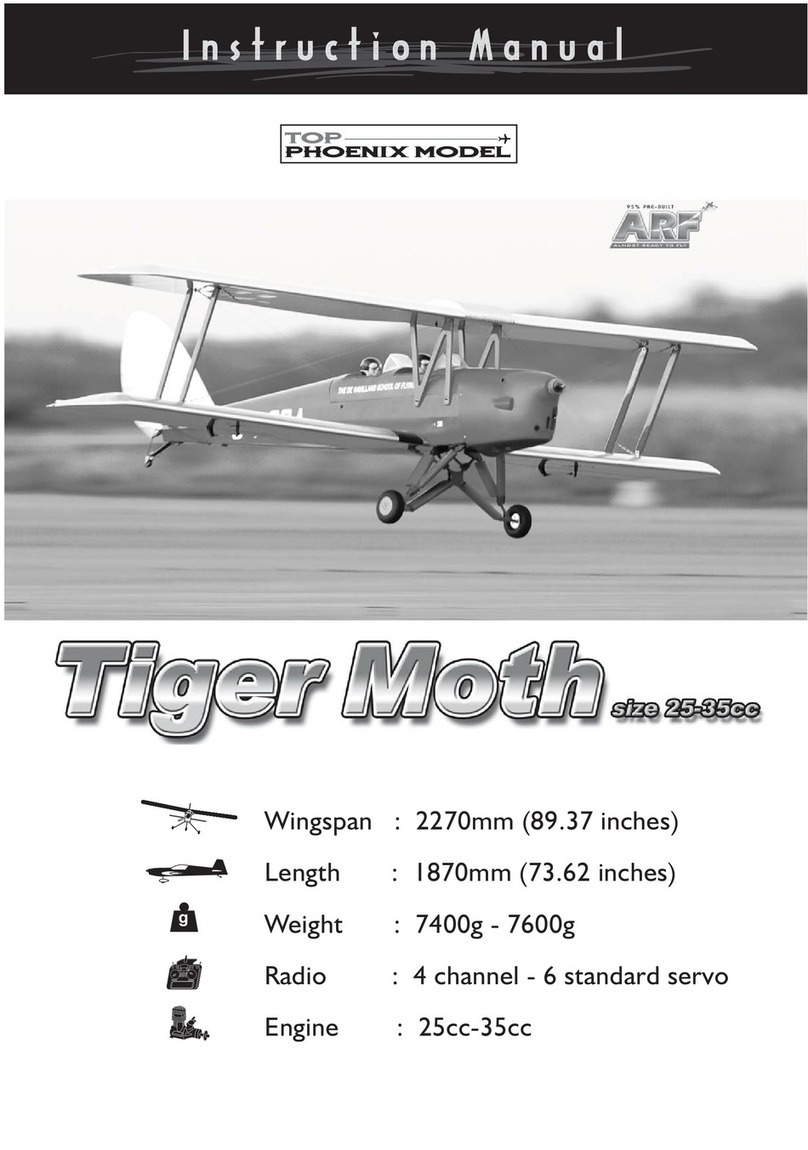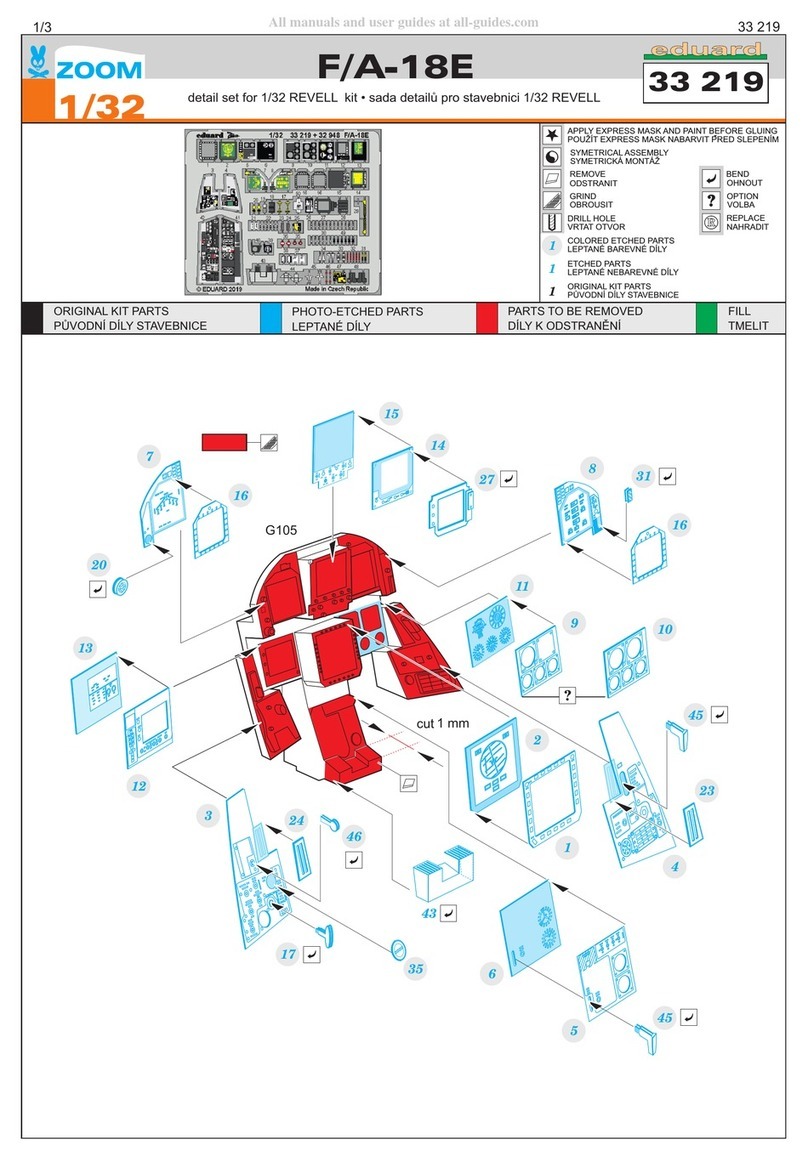PAU 150cc Extra 300SP ARF User manual

1
150cc Extra 300SP ARF
Instruction Manual
Congratulations and thank you for purchasing the Performance Aircraft Unlimited 123” Extra 300SP! The Extra
is arguably one of the most renowne d aerobatic aircraft ever produced. Walter Extra, who designed the original
Extra, named his aircraft by the horsepower rating of th e motor placed in them . The Extra 300SP is one of the
newest releases in full scale and now R/C use.
Our aircraft was designed with 2,694sq inches of wing area while keeping the total weight to a m inimum.
Whether you want an aircraft precise enough to compete in IMAC or 3D until you’re airsick, the PAU Extra fits
the bill. Its light weight give s you the stability in high-alpha to take it to the ex tremes of the flight envelope. If
tumbling maneuvers are your thing, our Extra 300sp will deliv er with picture perfect wa terfalls and blistering
tip spins that are not for the faint of heart.

2
We believe you will find this to be one of the finest flying aircraft on the market. Most modelers will find
assembly of this aircraft simple and straightforward. We recommend the builder follow the step-by-step
instructions to achieve the best performance and to ensure nothing was over looked. This manual also includes
tip sections throughout that may help you in key areas during assembly. Please familiarize yourself with this
manual before assembly.
This manual is broken down into ten chapters for simplicity:
Chapter 1 - Parts Inventory
Chapter 2 - Preparation for Assembly
Chapter 3 - Landing Gear and Tail Wheel Assemblies
Chapter 4 - Canopy and Fuselage Hatch
Chapter 5 - Engine Installation
Chapter 6 - Cowling installation
Chapter 7 - Rudder Installation
Chapter 8 - Hardware Installation
Chapter 9 - Radio and Control Surface Setup
Chapter 10 - Final Inspection and Pre-Flight
Additional items needed to complete this aircraft, which are not included:
An engine, within the recommend range, and propeller
8 channel computer radio and receiver recommended
Batteries and switches (with regulators if using Ion batteries)
Six aileron servos rated at least at 150oz of torque
Four elevator servos rated at least at 200oz of torque each
Two or three rudder servos rated at least at 800oz of torque combined
One throttle servo with push rod and links
Optional choke servo with push rod and links
One fueling dot or fueling device
3 to 4 feet of fuel tubing
Foam rubber
5” inch spinner (The prototype aircraft has a No Limitz 5” Ultimate style spinner)
30 to 45 minute epoxy
A bottle of thin CA
Covering iron
Various modeling tools for assembly
½ inch low tack masking tape
Using fewer servos then specified will not be covered under warranty! This is a large aircraft with very
large control surfaces that require better than average servos.
As with any aircraft this size, more care needs to be taken when flying. The faster the speed of the aircraft,
the higher load that can be imposed through extreme control inputs. Any maneuvers requiring full elevator
input, such as walls and parachutes, should be done at a low to moderate speed. Watch your speed!
Having said that, the Extra is a very well-behaved aircraft that will surely impress with its aerobatic
capability.

3
Chapter 1
Parts inventory
Place an “” to ensure your kit is complete:
1 Fuselage
1 Fuselage access hatch
2 Wing panels (1 right and 1 left)
2 Horizontal stabilizers (1 right and 1 left)
1 Rudder
1 Fiberglass Cowl
1 Pair of fiberglass wheel pants
1 Main landing gear
1 Pair of 4.5” Dubro Light wheels
1 Tail wheel and tiller assembly
1 Canopy
1 Carbon fiber wing tube
1 Carbon fiber stabilizer tube
4 Nylon wing retention bolts
10 H9 titanium pushrods/turnbuckles
1 set of Dubro wheel collars
1 pair of Dubro wheel axles
1 HD Dubro pull-pull system
1 Set of aluminum control horn assemblies
1 50oz Dubro fuel tank
12 HD 4/40 Dubro ball links
1 Set of additional various marked hardware
1 Vinyl graphics package
If any of these parts are missing immediately contact PAU.
If you need more information you can visit our support forum at: flyinggiants.com

4
Chapter 2
Preparation for Assembly
Professionals utilizing premium Ultracote covering carefully covered your model. Due to climate changes
during shipping, the models covering may have loosened and/or winkled. It’s a good habit to go over your
model with a covering iron to ensure all joints, seams, and edges are properly sealed.
Ultracote is a lower temperature film that seals and shrinks at lower temperatures. Make sure you set your iron
on a low temperature initially to get a feel for the correct temperature setting and adjust accordingly. Higher
temperatures will cause your covering to over shrink and distort. Also, use a sock over your iron to ensure a
scratch free finish.
Place an “” to ensure task completion:
Go over you model as necessary with a covering iron
to insure all joints, seams, and corners are sealed
properly.
Use your iron to ensure the areas where cutouts are
needed for your hardware are located and sealed
down, such as servos; tubes, and control horn
mounting locations.
Next, we’ll need to cut out the covering at the locations for
hardware and final assembly. Make sure you use a sharp hobby
knife so your cuts will be clean and straight.
Start with the fuselage, Locate and cut out the servo and
stabilizer tube locations.
Locate and cut the location for the anti-rotation pins and
mounting holes for the stabilizers.
Locate and cut the four mounting bolt locations for the
canopy and the two pull-pull exits (if you are using the
pull-pull setup).

5
Chapter 3
Landing Gear and Tail Wheel Assemblies
Now that we’re ready for assembly, we are going to start with the main landing gear first. You will need to
locate the following parts to begin assembly.
Place an “” to ensure task completion:
What you will need in this chapter for the main gear:
Main gear
One pair of 4.5” inch wheels
One pair of wheel pants
One pair of wheel pant cuffs
One pair of Dubro axles
Four wheel collars
Hardware pack marked “wheels”
Fuselage
Rudder
Tail wheel assembly
Not Provided:
½” and a 9/16” inch wrench
Blue loc-tite
Allen wrench for wheel collars
White wood glue such as Elmer’s or Epoxy
Slide the wheel cuffs partway onto the
m ain gear.
Fasten the axles to the main landing gear with
the lock nuts.
Using your four wheel collars and wheels,
center you wheels on the axles. Place the
collars as close to the wheels as possible but
ensure the wheels still rotate freely. Again, we
don’t want the wheel to move from side to side
and contact the wheel pants. Also, we strongly
recommend the use of loc-tite on the setscrews
of the wheel collars to prevent them from
vibrating loose.

6
Install the landing gear to the fuselage using the four 8/32 bolts, spring washers, and flat washers, and
compression nuts.
With the main gear on, it is time to set the landing gear cuffs. First, cut a slit along the neoprene tubing
and slide the tubing onto the top edge of the gear cuffs, where the cuffs will meet the fuselage.
Next, take some Goop glue and apply it to the landing gear where the bottom of the cuffs meet the gear.
Slide the cuffs up against the fuselage and use tape to hold them in place while the glue sets. Don’t set
the cuffs too tight against the fuselage, as the gear needs some room to flex without cracking the cuffs.
Now let’s get the tail wheel assembly installed.
Once the mains are on, find the pre-drilled hole for the tail wheel assembly. Insert the tail wheel
assembly and lightly tap in flush with a small hammer.
Next, mark the hold down locations, drill and mount them with the four wood screws securing the tail
wheel assembly. Remove the wood screws and coat the holes with thin CA, let dry, reinstall.
Install the steel tiller horn just behind the hinge line on the bottom of the rudder using the two small
wood screws.
Tip#2 Set aside your two tiller springs, we will install those later after the rudder is mounted.

7
With the aircraft resting on the landing gear, we are going to need to set the right angle for the wheel
pants. We used a ¾” thick wood board and placed it at the aft end of the wheel pant, resting the pant on
the wood. Mark the drilling location for the 4/40 bolts.
Drill the holes for the 4/40 bolts in the wheel pants at the locations you’ve marked.
Apply some white wood or epoxy glue to the inner side of the four 4/40 blind nuts and install the blind
nuts to the inside of the wheel pants.
Now you can install the wheel pants with the 4/40 bolts and washers. Don’t forget to use loc-tite here
again. Wheel pants tend to take the most vibration.

8
Chapter 4
Canopy and Fuselage Hatch
Place an “” to ensure task completion:
Gather the following for canopy and hatch
installation:
Canopy
Fuselage and Access Hatch
8 small wood screws
Four 4/40 bolts with two sealing
washers
Not Provided:
Drill and small drill bit for wood
screws
Canopy glue (optional)
Thin CA
Ruler
Install the hatch on the fuselage using four 6/32 bolts with the self-sealing washers.
Trial fit the canopy to the fuselage access hatch to determine screw locations.
Mark four evenly spaced locations for the screws on each side. Double check to ensure all the marked
screw locations will go into the hatch rail.
Remove canopy from the access hatch and drill the marked locations for the canopy screws.
Install the canopy using the small wood screws. If satisfied with the fit, remove the canopy and hatch
and wick a small amount of thin CA into each of the screws holes on the hatch. Once dried, reinstall
canopy with optional canopy glue if desired. The prototype used household Goop Glue to attach the
canopy to the hatch, in addition to the small wood screws. Caution! CA will fog the canopy if installed
before completely drying.

9
Chapter 5
Engine Installation
Your firewall is pre-mounted but our customers can select from a wide variety of engine choices. It is nearly
impossible to cover every engine installation choice in this manual but we’ll cover a few. Your aircraft was
designed around the 150cc to 170cc twin gas engines, as well as 200cc four-cylinder engines. A pipe tunnel is
provided and will accommodate canister or tuned pipe installations. If you choose to run tuned pipes, you will
need to remove the first air dam in the tunnel, which is designed for canisters.
DA-150/170 installation
The firewall is pre-marked so you'll just need to center your motor in the "+". Take a ruler and draw a
line across the entire firewall for the thrust line and offset centerline.
DA-150/170 users only. Center the motor based on your dimensions and drill out the holes for the ¼-20
bolts.
Mount the engine using 1/2" standoffs for the DA-150/170, 1/4-20 x 2" long bolts, and four blind nuts.
Now that you have the engine mounted, mark the locations for the fuel line and throttle push rod.
Remove the engine, drill those locations, and reinstall engine.
We recommend 4/40 push rods for throttle and/or optional choke servo. Also ensure there is no metal-to-
metal contact from the throttle/choke to the servos. 2/56 Ball links for 4/40 rod (not included) will prevent
the aforementioned metal-to-metal contact and will bolt nicely to your engine’s carburetor.

10
Chapter 6
Cowling installation
Place an “” to ensure task completion:
What you will need in this chapter:
Fuselage and cowling
Four 6/32 bolts with spring and lock washers
Not Provided:
A 5” inch spinner
A Dremel tool
A facemask and eye protection
Pencil or dry erase marker
Always wear a mask and eye protection while cutting fiberglass. Take your time while installing the cowl.
With care you will end up with a professional installation that will make an impression at the field.
Close the choke and place a piece of tape over the carburetor inlet and exhaust outlet to keep out any dust while
setting up your cowl. Since the cowl is preset and uses a ring to mount, there will not be much to do here.
First cut out the bottom opening for cooling. For
installations using canisters, you will only need to open the
bottom of the cowl to exit the air from the cowl. If you’re
using stock exhaust stacks, it may be necessary to cut away
the bottom portion of the cowl-ring for it to pass the
exhaust.
If using stock mufflers for the DA-150/170, we recommend
the compact style.
Remove the cowling and cut out the remaining areas to be
trimmed.

11
Chapter 7
Rudder Installation
Place an “” to ensure task completion:
What you will need in this chapter:
Rudder and fuse
Pull-pull hardware
Not Provided:
30 to 45 minute epoxy
Two cycle oil
Next, we will install the hardware on the rudder before
installing it. Find the pre-drilled hard point, remove the covering and insert the longer 6” stainless
treaded rod provided and discard the 4” rod.
Install the Dubro fasteners to the rod. Use loc-tite as
shown if you are not planning on using the lock nuts.
Now add the control horns placing them at 2” centered
from the hinge line. If you are using a rudder pull-pull
servo arm larger than 4”, adjust the distance of the horns
accordingly.
Now were going to prep the hinges for installation. Take a
small drop of oil and place it in each of the pivot points of
your hinges. The oil prevents excess epoxy from bonding the joint.
Apply epoxy into the trailing edge holes of the vertical
stabilizer. Now apply epoxy to the hinges.
Carefully insert the control surface into the stabilizer and
butt the two surfaces together. Move the surface back and
forth a couple of times to make sure all the hinges are
aligned correctly and the desired throw is attained. You
will want at least 45 degrees.
Use some masking tape to hold the surfaces together and
let cure for at least eight hours.
Install the tiller springs you set aside in chapter 2 to the tiller horn and tiller.
Tip#5 Optional step. After your epoxy has cured, it would be a good time to seal all of your hinge gaps prior
to installing the rest of the hardware. This can provide you with a better flying aircraft by increasing control
surface performance and preventing possible flutter. Clear or matching covering material can be ironed in
place to fill any gaps on the bottom of your control surfaces.
Take approximately a one-inch strip of covering the length of your surface. Fold it in half while placing into
the gap with the control surface fully deflected up and iron it in place. Check to make sure you still have full
surface travel once you have completed.

12
Chapter 8
Hardware Installation
We provide high quality aluminum control horn assemblies included with our latest generation of PAU aircraft
kits. We believe these lightweight assemblies are the best available and can also be purchased separately from
PAU. Place an “” to ensure task completion:
What you will need in this chapter:
The entire airframe
Ten H9 titanium push rods
Ten sets of aluminum control horn assemblies
Ten steel posts
12 HD Dubro ball links
One 50oz Du-bro fuel tank
Not Provided:
Six 150oz or better servos for ailerons
Four 200oz or better servos for elevators
Two or three servos for rudder equaling 800oz
One throttle servo 70oz or better
Ten 1.5” aluminum servo arms
One or two 3” arms to tie rudder servos
One 4” offset rudder servo arm
One Fuel dot or other fueling device
Some foam rubber for mounting receiver, ignition module, and fuel tank
Install all your flight control servos with the output shaft closest to the control surface.
Install 6 150oz or better servos for the ailerons in the servo trays located in the bottom of the wings.
Install 4 200oz or better servos for the elevators in the servo trays located in the bottom of the horizontal
stabilizers.
Install two or three equaling 800oz or better servos for the rudder in the servo tray inside the fuselage.
Install your throttle and or choke servos in the forward bays provided.
First you need to find the pre-drilled holes for the steel posts. Install the aluminum control horn
assemblies to each surface with the M4 bolt in the down position. Use blue loc-tite on the aluminum
base to ensure the bolt does not try to back out under vibration. Screw on the horns on to the posts.
Do not use loc-tite installing the horn.

13
Make sure your elevator servos are centered and mount your servo arms parallel to the hinge line.
Take some masking tape and tape the elevator counter balances to the stabilizers so that they are in a
center position.
Screw in your two HD ball links onto the counterclockwise ends of the 2.5” H9 push rods and screw the
other end into the control horn. Ensure everything is still centered. Don’t forget to add locknuts to the
4/40 bolts attaching the ball link to the arm.
Ensure aileron servos are centered and mount your arms parallel to the hinge line.
Be sure that you install the horns at the same height from the hinge line (see attached). By doing so you
will have very little servo matching to do afterwards.
Screw in four HD ball links onto the counterclockwise ends of the 2.5” H9 push rods and screw the
other end into the control horn. Ensure everything is still centered. Don’t forget to add locknuts to the
4/40 bolts, attaching the ball links to the arms.
Ensure your rudder servo is centered and mount
your rudder servo arm.
Two Futaba 9157 servos were used on our test
aircraft. You will need additional servo arms to
tie the two or three servos together as well as a
servo matching device.

14
Install your pull-pull cable using the 60lbs leader provided.
Cables should be crossed to avoid any rubbing on the exits. It is normal for the non-pulling side of the cable to slacken a little when the rudder
is deflected.
Install your tiller springs you set aside earlier.
Assemble the fuel tank according to the directions provided on the package. You will need to decide
whether you want a two or three-line setup. With a two-line setup you will need an additional “T”
fitting in the carburetor line that connects to your fuel dot or fueling device. Make sure you use Tygon
fuel tubing inside the tank for the clunk as well.
Install the fuel tank just in front of the wing tube using zip-ties or hook and latch (Velcro) straps. Place
a loop in the vent line over the top of the tank to prevent fuel loss during flight and improve flight times.
Take small zip-ties or fuel line clamps and fasten to all the points where the fuels lines connect.
Locate areas on the fuselage to install your switches. Some scrap lite-ply may be used as a doubler
where the switches are mounted.
Install the fuel-filling device in a location of your choice. In this case, we installed it just front of the
right side receiver switch.

15
Install your throttle push rod. Again as mentioned earlier, we do not want metal-to-metal contact at the
attachment point on the engine. Use a 4/40-rod with a 2/56 ball link for 4/40 rod to attach the push rod
to the motor.
Once satisfied with your throttle setup, mount the cowl using the four 8/32 bolts provided and attach the
prop and spinner.
Install the horizontal stabilizers at this time. Install the carbon fiber stabilizer tube. Slide in each half
and secure them with the four 4/40 retention bolts.
Install the horizontal stabilizers at this time. Install the carbon fiber stabilizer tube. Slide in each half
and secure them with the four 4/40 retention bolts.
Let’s install the wings at this time and check our center of gravity (CG). Install the carbon fiber wing
tube. Slide in each wing panel and secure them with the four nylon wing retention bolts.
Tip#8 If the wing is tight you can coat the tube with a little baby powder to aid the insertion of the wing
panels.
Tip#9 For added protection in case the wing retention bolts back out during flight; you can add hitch pins to
the anti-rotation pins of the wing. With the wings installed, mark the anti-rotation pins ¼ inch from the
fuselage side. Remove the wings and drill a small hole in the anti-rotation pins. You can find appropriate
sized hitch pins at most local hardware stores. Re-install wings and insert the hitch pins for added
protection. While this step provides extra protection, we have not had problems with wing bolts backing out
in the prototype aircraft.

16
Now we’re ready to check the CG and install your remaining hardware. We recommend the CG be located in
the middle of the wing tube as an excellent all-around CG for precision and 3D flight.
Check CG at this time and place your batteries and remaining hardware in locations to attain the desired
CG. If satisfied, mount your remaining hardware.
Congratulations! You have just completed assembly of your Extra 300SP. Now would be a good time to install
the optional vinyl graphics included with your kit.
Chapter 9
Radio and Control Surface Setup
Now we are ready to setup your aircraft for flying. Included is this manual are templates for measuring surface
throw you may use if desired. We recommend that you setup your aircraft on low rates for initial flights until
you become familiar with the aircraft and its capabilities.
The recommended low rates for this aircraft are:
20 degrees for ailerons with 0 to 20% expo
12 degrees for elevators with 0 to 20% expo
30 degrees for rudder with 0 to 20% expo
The recommended high rates for this aircraft are:
35 degrees for ailerons with 40 to 70% expo
45 degrees for elevators with 40 to 70% expo
45 degrees for rudder with 30 to 70% expo
…or as much as you can stand for hardcore flyers!
Place an “” to ensure task completion:
What you will need in this chapter:
Completed airframe
Radio
Throw templates or meter
Cut out the templates for surface throw. These should be located on the last page of this manual.
Tape each one in place using the horizontal line as a reference point to each stabilizer at the counter
balance and at the inside of the wings where the ailerons meet.
Set your throws accordingly. Double check to make sure nothing is binding to include the throttle and
or choke servos and their linkages. Also, ensure all surfaces and controls are moving in the proper
directions.

17
Chapter 10
Final Inspection and Pre-Flight
Welcome to the final chapter prior to your maiden flight! We hope you have enjoyed building your Extra.
Let’s go over the airframe and perform a pre-flight to make sure everything is in order.
Inspect the airframe for any visible damage and loose covering that may have occurred during the build.
Inspect the main landing gear and tail wheel assembly. Ensure all mounting hardware and collars are
fastened properly.
Inspect your motor installation and cowl to ensure all bolts are tight and the muffler is firmly mounted in
place. Check the motor and muffler for possible contact with the cowl. Inspect ignition module and
spark plug wire for proper mounting. Check propeller and spinner to ensure they are both secure.
Inspect the inside of the fuselage to ensure your batteries, switches, regulators (if equipped), fuel tank
and lines are securely fastened. Check nylon wing bolts to ensure they are in place and secured.
Inspect all control surfaces and control surface hardware. Gently tug on each surface to make sure the
hinges are properly bonded. Check the four 4/40 horizontal stabilizer fasteners and ensure they’re in
place and secured.
Check all servos for mounting screws. Check servo arm mounting screws and inspect that the 4/40 links
have been secured with lock nuts.
Fill fuel tank and inspect for any leaks.
Check your batteries in both your aircraft and radio to ensure they are fully charged
Turn on radio to inspect all controls for binding, proper direction and throw while on high rates.
Re-check CG. It should not be behind the wing tube for initial flights.
Secure the aircraft using a buddy or hold down and start the engine according to the manufacturer’s
guidelines. Don’t forget to set your throttle to idle prior to ignition.
Perform a proper range check with the engine running, using your radio manufacturer’s instructions.
Make sure you set low rates for your maiden takeoff and enjoy!
This concludes your pre-flight checks. After your maiden flight, repeat these steps to perform a post flight to
ensure nothing has loosened. It’s always a good habit to use a checklist like this one to go over your aircraft
prior to the first flight of the day.

18
Flying!
We believe you will find this aircraft finest aircraft you’ve ever flown. High-alpha stability gives you solid
control and confidence to bring it right down on the deck! For contest flying such as IMAC, a CG on the wing
tube offers great precision and little coupling.
Every airplane has structural limits, and the larger the plane is, the more critical it is to understand and
respect these limits. This is particularly true for 3D aerobatic planes, since by design, these planes are light
weight, are over powered, and have oversized control surfaces.
Pilots need to use proper throttle management, and avoid high speed when executing high stress maneuvers
such as Walls, Parachutes and Blenders. As a general rule, the throttle must be at idle position whenever the
nose is pointed down (whether at vertical or 45 degrees down line).
Planes must be inspected frequently, looking for any loosening screws, bolts and glue joints. Servos and
linkages must be free of play or “slop”, as this is a major cause of flutter (and crashes).
Understanding and applying these few safety and maintenance guidelines will help you get many enjoyable and
rewarding flights with your Giant Scale Plane.
==========================================================================
We hope this aircraft offers you many years of enjoyment. Thank you again for choosing PAU and look for
exciting future products.
Additional products from PAU:
43% Edge 540
36% Edge 540.
35% Extra 300SP
30% Extra 300SP
30% Edge 540
27% Pitts Challenger.
27% Pitts Bulldog
37% Ultimate Biplane.
Additionally, PAU carries a complete line of high performance laminated props, lightweight spinners, and
more!
New! Aluminum Hardware sets that weighs next to nothing. Time to chuck your old stuff, it’s now obsolete!
Something bigger this way comes! Stay tuned.

19
Throw Template
If printing from Adobe, turn off page scaling.
Cut out around all the dotted lines.
Table of contents
Other PAU Toy manuals
Popular Toy manuals by other brands

Mega Bloks
Mega Bloks Marvel Super Tech Heroes The Amazing... manual
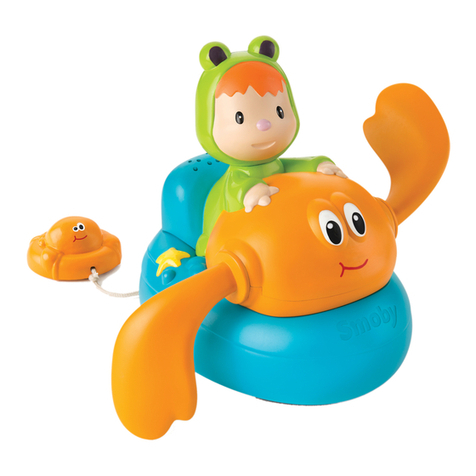
Smoby
Smoby Cotoons 110611 quick start guide

Eduard
Eduard ZOOM FE 941 quick start guide

Hacker
Hacker EDGE 540 v3 Toxic manual
Mattel
Mattel PIXEL CHIX ROOMIES HOUSE instructions
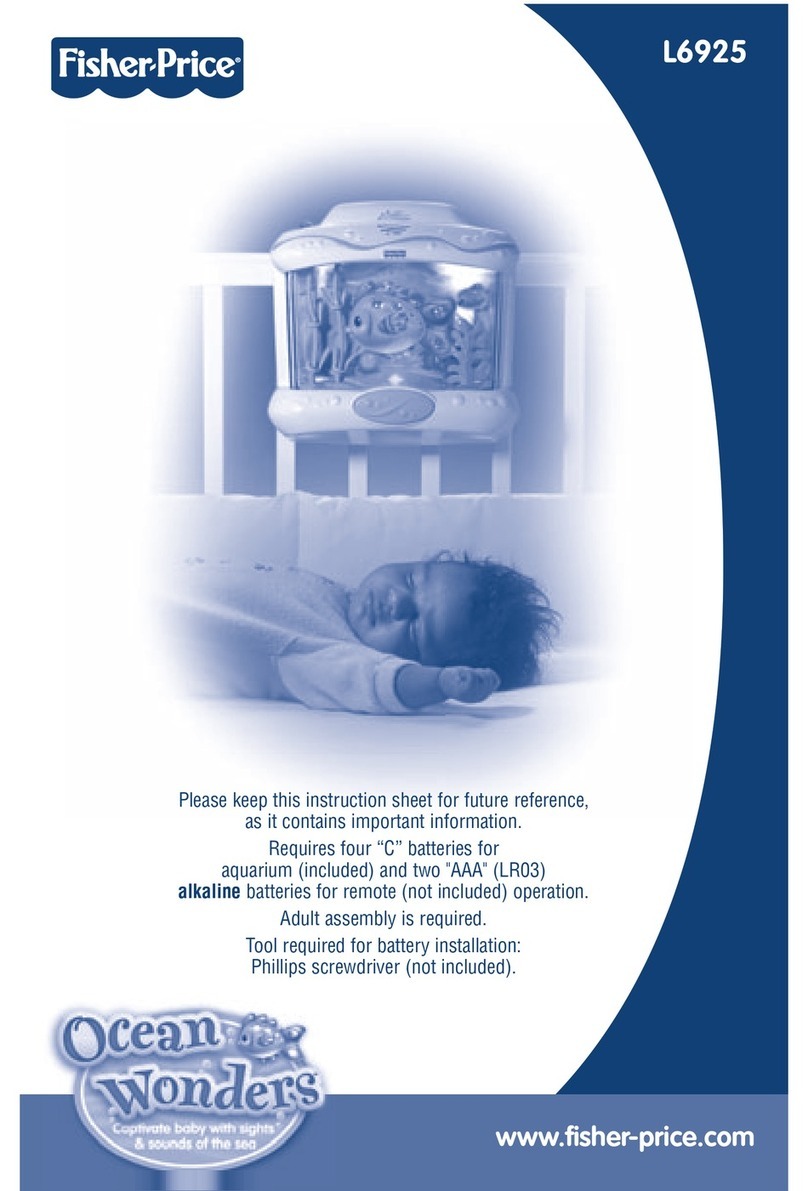
Fisher-Price
Fisher-Price OCEAN WONDERS L6925 instruction sheet
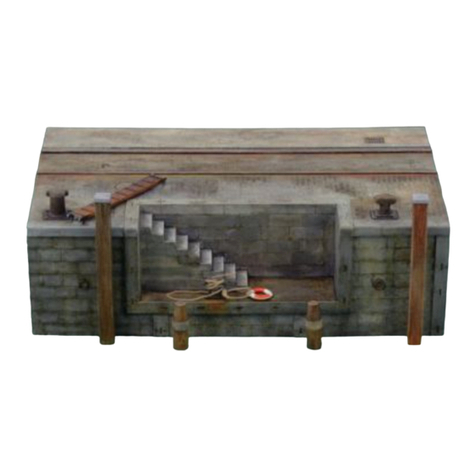
Italeri
Italeri 5615 quick start guide
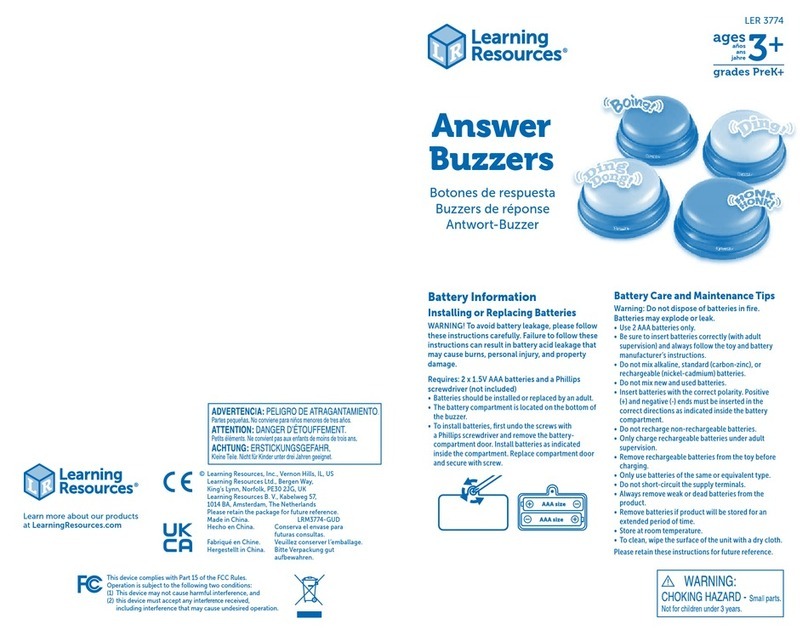
Learning Resources
Learning Resources LER 3774 quick start guide
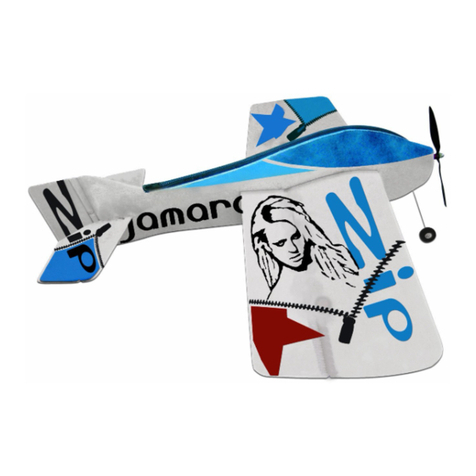
Jamara
Jamara Zip instruction manual

MTHTrains
MTHTrains PREMIER AUXILIARY TENDER operating instructions
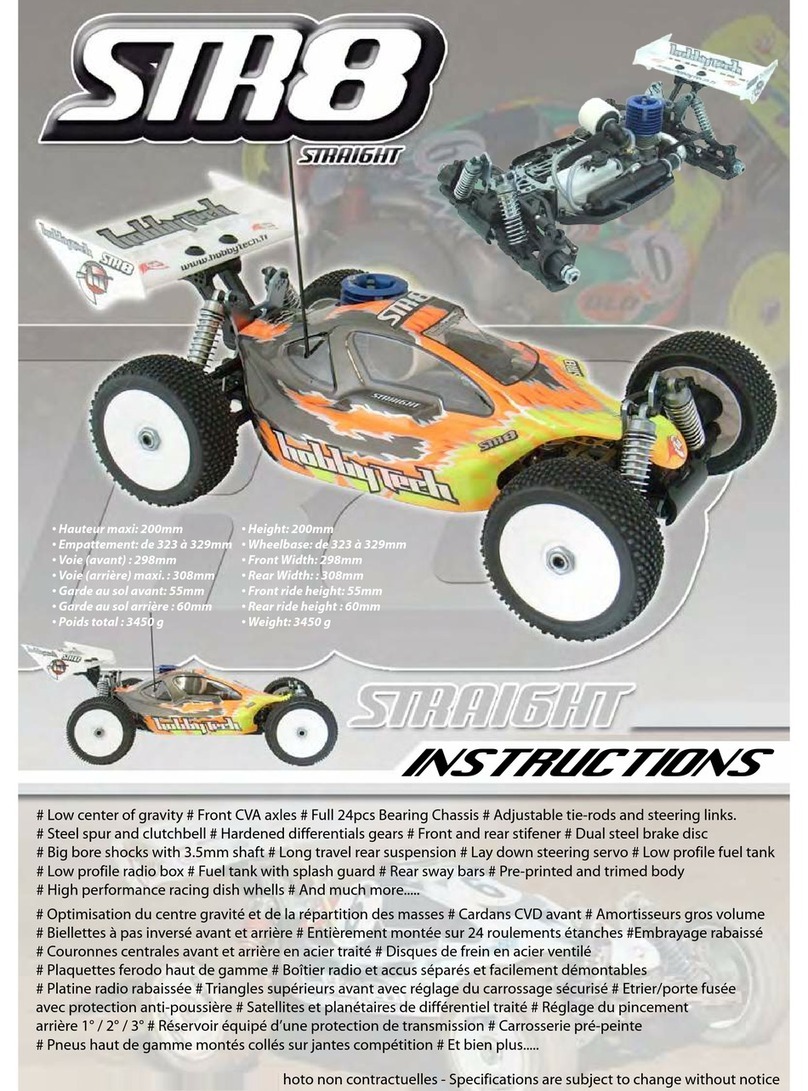
Hobbytech
Hobbytech STR8 instructions

Black Horce Model
Black Horce Model BH39 Instruction manual book

